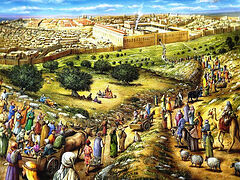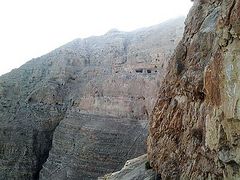Jericho has a glorious history. We read in the Old Testament that it was the first city captured by the Israelites led by Joshua on entering the Promised Land. Its stone walls and towers are considered to be almost the first exclusively military defensive structures (built 8,000 years before the Birth of Christ). They fell down on the seventh day from the sound of the famous Jericho trumpets.
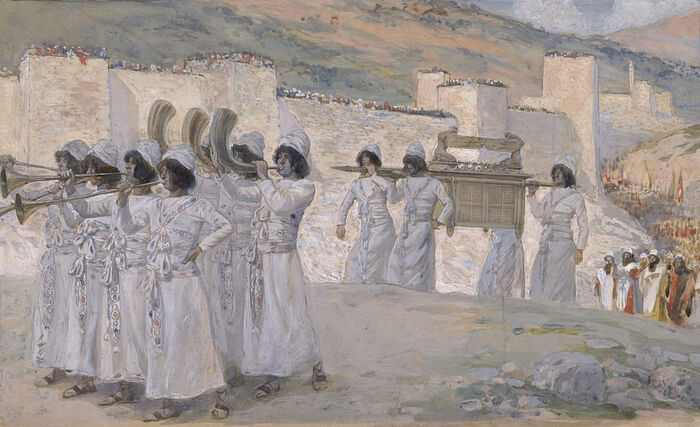 James Tissot. The Seven Trumpets of Jericho
James Tissot. The Seven Trumpets of Jericho
The city is located about twenty-three miles away from Jerusalem. Here the Archangel Michael appeared to Joshua. The Prophets Elias and Elisha visited this city. Not far from Jericho the Prophet Elias ascended into Heaven: And it came to pass, as they still went on, and talked, that, behold, there appeared a chariot of fire, and horses of fire, and parted them both asunder; and Elijah went up by a whirlwind into Heaven (4 Kings 2:11).
In the ninth century B.C. the house of the poor Shunammite woman, whose sick son was healed by the Prophet Elisha, stood in the center of the city. A holy spring has existed there ever since. 2,000 years ago the Holy Family stopped here on their way to Egypt. Later, the house of Zacchaeus, the chief tax collector in Jericho, stood on this site, which the Lord visited on the eve of His Crucifixion on the Cross. From here He went to Jerusalem. Now there is a Greek Orthodox monastery in honor of the Prophet Elisha here. Through the efforts of the monks, the tree that Zacchaeus climbed in order to see the Lord has been preserved.
We entered the cozy courtyard of the monastery, where a Greek hieromonk greeted us. After looking around the church, we gathered at the famous sycamore tree. And, behold, there was a man named Zacchaeus, which was the chief among the publicans, and he was rich. And he sought to see Jesus who He was; and could not for the press, because he was little of stature. And he ran before, and climbed up into a sycomore tree to see Him: for He was to pass that way. And when Jesus came to the place, He looked up, and saw him, and said unto him, Zacchaeus, make haste, and come down; for to day I must abide at thy house. And he made haste, and came down, and received Him joyfully (Lk. 19:2-6).
Oh, blessed sycamore tree! If only we could, like Zacchaeus, forgetting about everything in the world—about our positions, our earthly calling and age—and climb a tree swiftly, desiring to behold Christ with our eyes, catch a glimpse of Him if only for an instant and imprint His Most Pure Face on our hearts forever and suddenly hear: Come down; for to day I must abide at thy house. If only each one of us could hear His call: My son, give Me thine heart (Prov. 23:26), “and I will make the Heavenly Kingdom in it."
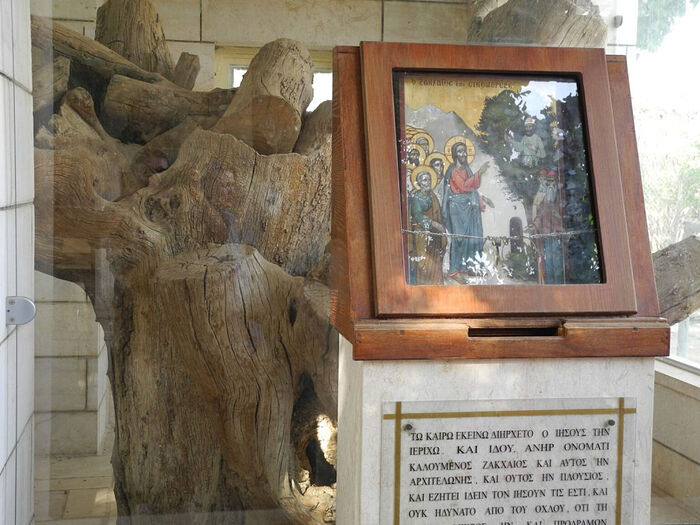 Zacchaeus’ sycamore fig tree in Jericho
Zacchaeus’ sycamore fig tree in Jericho
But we’re all constantly rushing, running and fussing... Big cities, big plans, big illusions about our “indispensability”, “importance” and “exclusivity”... and all we need to do is stop, lose contact with the hustle and bustle of the world around us for a short while and withdraw into ourselves in complete stillness of thought with only one question: “My God, where art Thou?” Or, imitating Zacchaeus, abandon everything, and mentally climb like a child up our “sycamore tree”: “My God, where art Thou?” There has never been a single case when He didn’t respond.
The Oak of Mamre
We waited a long time for the monastery gate to open. Local children jumped around the cars, looking into the windows and examining us curiously, as if in a circus. We understood perfectly well that for them it was rare and exotic entertainment. Lately, pilgrims have been able to get to the Arab territories less and less often, and Hebron is an Arab city.
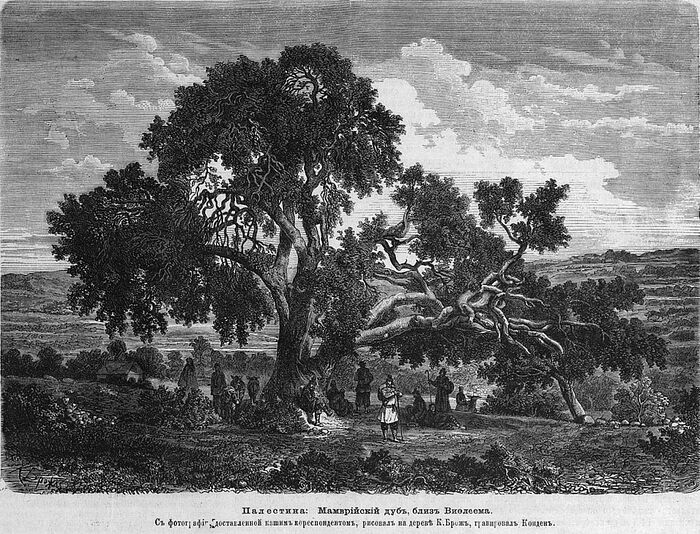 Oak of Mamre, a drawing from a photograph from 1862
Oak of Mamre, a drawing from a photograph from 1862
This oldest of the cities mentioned in the Holy Scriptures is located about twenty-five miles south of Jerusalem. Hebron is called Al-Khalil in Arabic. This is the name of Abraham, meaning “beloved” (of God). Hebron is considered one of the four holy cities in Islam. And what about Christianity?
At last the gate opened and we drove into the monastery area.
The Oak of Mamre, or, rather, what remains of it, was once a giant, but is now a dry skeleton, propped up by large metal beams for stability. It welcomed us as the master of this area and a witness to many historic events. Under the once magnificent branches of this oak tree, Abraham pitched his tent, and here God appeared to him in the form of three angels. Abraham, as a generous host, invited the guests to have a rest under the shade of an oak tree, prepared a treat with the help of his wife Sarah, and he stood by them under the tree (Gen. 18:8). This oak tree is old, very old, the “patriarch tree” of the since disappeared forests of Palestine.
I looked hopefully at a small shrub two yards away from the oak, which is withered up to the base.
“Has it grown from its roots?” I asked a Russian monk who accompanied us.
“No,” I heard in reply. “This is a holm oak, which has nothing to do with the Oak of Mamre.”
I touched its prickly leaves cautiously.
“Is there not a single leaf or twig on the Oak of Mamre left?”
“None,” the monk replied somewhat sadly.
“So is it the end?” I asked, meaning the end of the world.
“Take care for your soul above all. God alone knows the precise time.”
“I see,” I drawled.
“And these two oaks next to each other are called Sarah and Isaac,” our compatriot finished his short tour.
 The skeleton of the Oak of Mamre in Hebron
The skeleton of the Oak of Mamre in Hebron
Throughout my journey back I recalled his pensive look, and thought, “He’s probably pining for his homeland… Well, his melancholy is not about the end of the world, because God alone knows the day and hour (cf. Mt. 24:36)! Surely he’s homesick,” I finally concluded. “Yes, it can't be otherwise."

